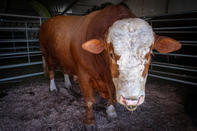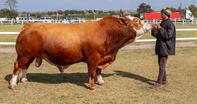Milk production starts after calving. Getting cows pregnant is therefore one of the most important management actions on a dairy farm.

Two outcomes are possible when cows conceive: First is the possibility of a lactation period, and secondly, setting the genetic merit of the progeny.
Breeding in farm animals is the deliberate improvement of a breed of the herd or to improve specific traits such as increasing milk yield. Genetic improvement occurs when better-performing parents are selected.
As cows make up a dairy herd, it follows that the bulls used for getting cows pregnant help determine herd improvement. Sire (father) selection has a long-term effect on the genetic merit of a dairy herd.
The production performance by the daughters of sires selected today is only seen four years later. The present commercial dairy herd consists of cows born 3 to 8 years ago.
A breeding objective for a dairy herd should aim at improving the traits of the stock produced. As a dairy herd primarily produces milk, it makes sense to select bulls that have a high genetic merit for milk yield as that increases the possibility for high producing daughters.
However, the selection of a bull for a single trait like milk yield is not recommended as there are other traits that also affect the economic performance of cows such as cows that produce the most milk from the available feeds. Milk should have high fat and protein percentages. Cows should have long and productive lifetimes.
Bulls vs Artificial Insemination

Commercial dairies make use of artificial insemination (AI) to get cows pregnant, however, natural service can also be used. Bulls for natural service should be bought from established breeders participating in the nation milk recording scheme.
This scheme provides estimated breeding values (EBV’s) for all animals in the herd. Breeding values indicate the genetic merit of animals. Similar information is available for bulls born in the herd. Never buy bulls that have no genetic information.
The feeding cost of a bull can be around R30/day (2018). This excludes the cost of the bull and the labour. If a bull is used on 10 cows per year the mating cost would be around R500 per service. Semen for AI can be bought from local and international AI companies.
Bull guides are like brochures with a large amount of genetic information for each bull as well as information on the genetic merit for milk yield and body conformation traits for each bull.
One straw of semen is used per insemination, but between two and four straws may be needed to get a cow pregnant. This depends on the technique and skill of the inseminator. The price of straws ranges from R60 to R275 (2017).
How to Choose a Bull
For sire selection, as a start, obtain a list of all the available bulls from the semen company or semen agent. With only a small number of bulls to choose from, sire selection becomes difficult, therefore the list should contain at least 20 bulls. This list should also contain the price for each straw of semen. Bull guides often have indexes with a ‘net merit’.
The net merit combines 12 different traits into a single value. Certain semen companies offer a service to farmers whereby the farmer’s cows are rated according to their build, and a breeding program is then developed.
Information about the cows is loaded into a computer program, which will automatically recommend certain bulls according to the traits needed for that specific dairy farm. It would also recommend specific bulls for individual cows.
These programs use corrective mating to improve body conformation traits while simultaneously improving or maintaining milk production. This could simply be a combination of EBV’s for fat and protein yield using milk prices for fat and protein as guidelines.
The index could also be extended to include milk production, fertility, productive life or body conformation traits like stature. Rank the list of bulls for the chosen index from high to low. Pick, according to the index, the best five bulls to be used in the herd.
By Dr Carel Muller